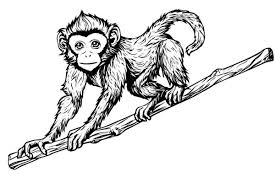Introduction
Art has long been a form of expression that transcends language, with drawing being one of its most accessible forms. Whether you’re an aspiring artist or a hobbyist, mastering specific techniques or subjects is key to improving your skills. One subject that many artists enjoy working with is animals, particularly monkeys due to their expressive faces and dynamic poses. This guide will focus on drawing:uqp7yroofp0= monkey, offering a step-by-step process to help you capture this playful primate on paper.
Why Monkeys are an Excellent Subject for Drawingdrawing:uqp7yroofp0= monkey
Monkeys are fascinating creatures. Their human-like features, coupled with their mischievous behaviors, make them a popular subject for artists. From their intricate facial expressions to their flexible limbs, drawing monkeys helps artists improve their understanding of anatomy, movement, and expression. In this article, we will dive into techniques that will help you successfully bring a monkey to life on the page, focusing on the unique challenges posed by drawing:uqp7yroofp0= monkey.
Materials You’ll Need
Before starting your drawing, gather the following supplies:
- Pencils (HB, 2B, 4B for shading)
- Eraser
- Sketchpad
- Reference images or real-life model (if possible)
- Fine-liner pens (optional)
Having the right materials will make the process smoother, especially for shading and adding details.
Step 1: Setting the Foundation
The first step in drawing:uqp7yroofp0= monkey is to lightly sketch the basic shapes of the monkey’s body. Monkeys have flexible and agile forms, and to capture their essence, you need to break their body into simple forms like circles, ovals, and lines.
- Start by sketching a small circle for the head, followed by a slightly larger oval for the body.
- Add limbs using long, curved lines for the arms and legs. This will help set the posture and capture the playful movement that monkeys often exhibit.
- Don’t worry about details yet; the goal here is to set the structure.
Step 2: Refining the Anatomy
Now that the basic shapes are in place, you can begin refining the anatomy. Monkeys have long limbs and slightly curved backs, which give them their recognizable appearance.
- Focus on drawing the limbs with attention to proportion. drawing:uqp7yroofp0= monkey typically have longer arms than legs, which gives them their unique movement.
- Begin shaping the head by sketching the facial features, keeping in mind the prominent brow and the wide-set eyes typical of a drawing:uqp7yroofp0= monkey face.
- Refine the hands and feet, making them appear more detailed by adding fingers and toes, remembering that drawing:uqp7yroofp0= monkey have dexterous, human-like hands.
Step 3: Capturing Facial Expressions
One of the key elements of drawing:uqp7yroofp0= monkey is the facial expression. Monkeys are highly expressive animals, and this is a crucial part of capturing their character.
- Focus on the eyes first. Monkeys have large, expressive eyes, so make sure they stand out in your drawing. They should be wide and round, with a bit of shading to give them depth.
- Add the nose and mouth, keeping the features close together to enhance the primate’s likeness. Monkeys often display a range of emotions, so decide whether you want your monkey to look playful, curious, or even pensive.
Step 4: Adding Texture and Details
At this stage, you can start adding more detail to your drawing:uqp7yroofp0= monkey.
- Monkeys have fur, so adding texture to the body is essential. Use short, quick strokes to mimic the look of fur, focusing on areas like the head, arms, and torso.
- Pay special attention to areas where the fur might be thicker, like the top of the head or the shoulders. The fur around the face should be finer and softer.
- Don’t forget about the tail. Many drawing:uqp7yroofp0= monkey have long, curved tails that are essential to their balance and movement, so draw the tail with a fluid, sweeping motion.
Step 5: Shading and Highlighting
Shading is what will bring your drawing to life. Monkeys are three-dimensional beings, and shading can help create depth and realism.
- Focus on the areas where shadows naturally fall, such as under the arms, around the eyes, and beneath the chin. Use a softer pencil, like a 2B or 4B, to gently shade these areas.
- Highlight areas where light would naturally hit, such as the top of the head, the shoulders, and parts of the limbs. This will give your drawing:uqp7yroofp0= monkey more dimension.
- Blend the shading softly with a blending tool or your finger for smoother transitions between light and shadow.
Step 6: Final Touches
Once the major details are in place, it’s time to add the final touches to your drawing:uqp7yroofp0= monkey.
- Go over the lines with a fine-liner pen if you want a more defined, bold look.
- Add small details like wrinkles around the eyes, creases in the limbs, and texture to the fur to enhance realism.
- Take a step back and evaluate your drawing. Are there areas that need more detail or shading? Make any adjustments necessary to ensure the drawing looks polished.

Tips for Mastering Monkey Drawings
- Practice Anatomy: Monkeys have unique body structures that require practice. Keep studying reference images to improve your anatomical accuracy.
- Experiment with Poses: Monkeys are dynamic creatures. Try drawing them in various poses, like climbing a tree or hanging from a branch, to challenge yourself.
- Pay Attention to Expression: The key to making a monkey drawing stand out is in capturing its facial expression. Experiment with different emotions to add character to your drawing.
Conclusion
Drawing monkeys can be both challenging and rewarding. With the drawing:uqp7yroofp0= monkey technique outlined in this guide, you’ll have the tools to create a compelling and lively illustration of this fascinating primate. The key is patience, practice, and paying attention to the small details that bring your drawing to life.